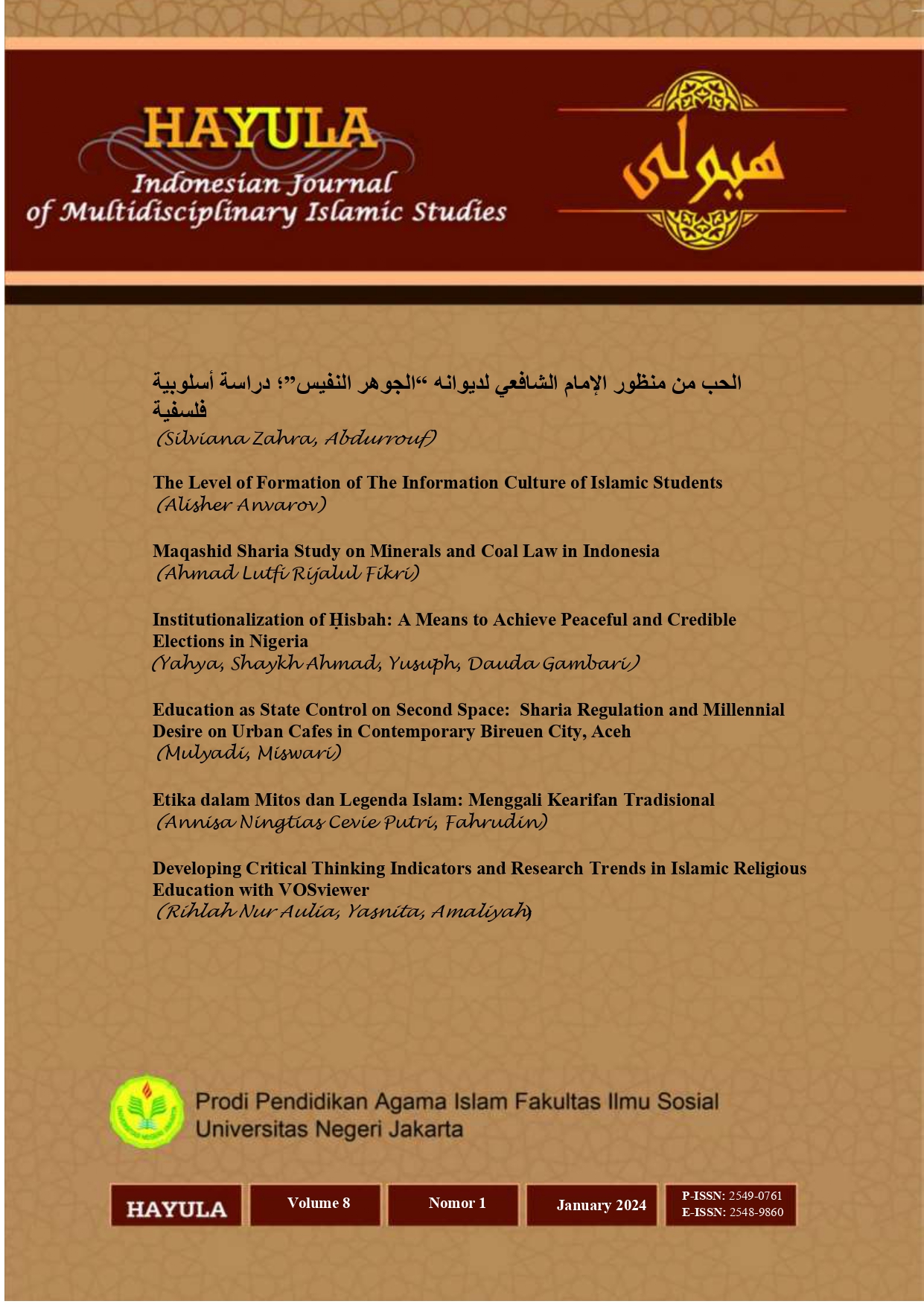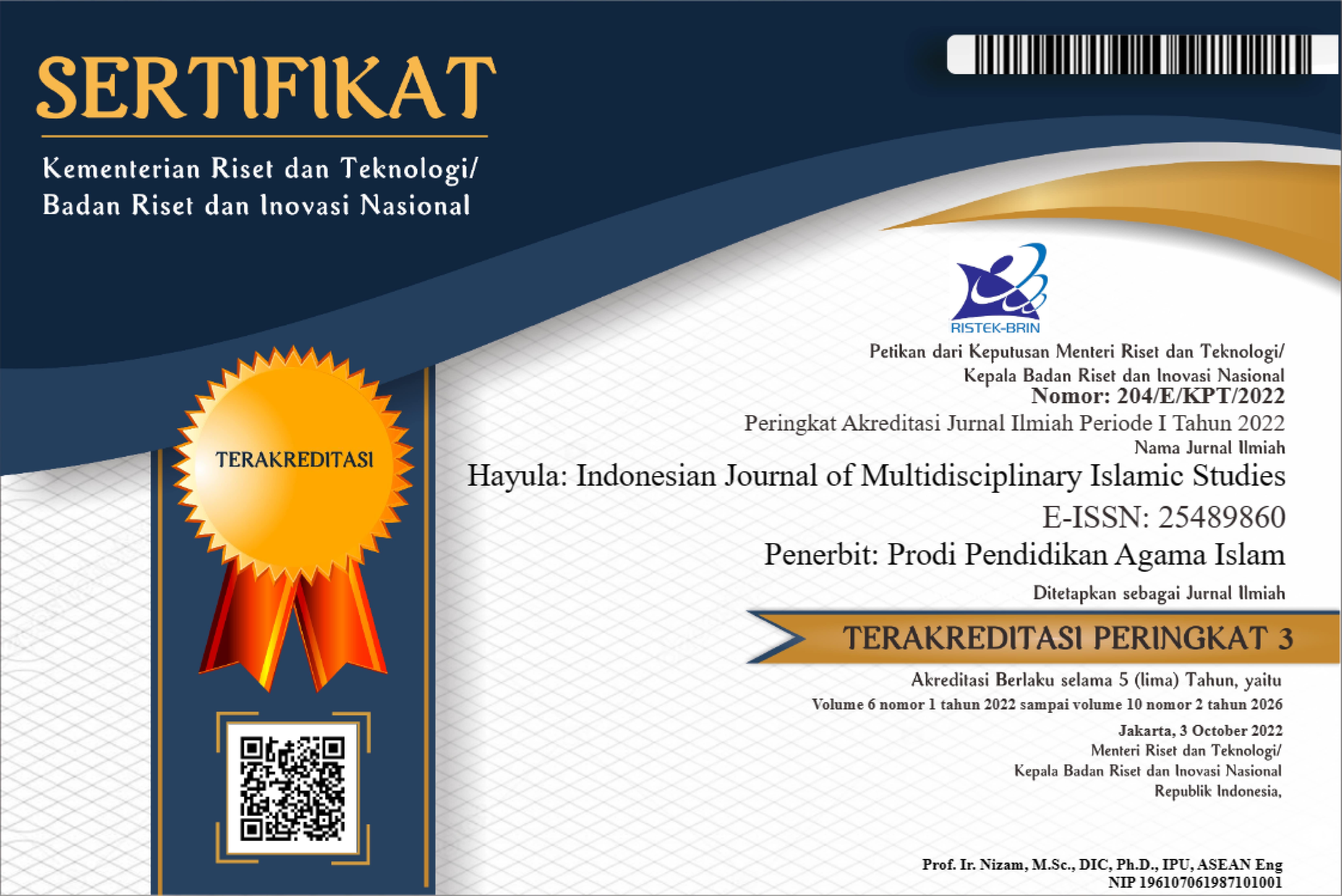The Contribution of Arabic to the Process of Scientific Advancement in the XIII-XVIII Century AD
DOI:
https://doi.org/10.21009/hayula.009.01.06Keywords:
Arabic Language, XIII-XVIII Century, Development of Science, Islamic CivilizationAbstract
This research examines the contribution of Arabic to the advancement of science in the XIII-XVIII centuries AD. This era was marked by the spread of Islam, which influenced civilization, including the mastery and development of science. However, research on the specific role of Arabic in knowledge transfer and innovation is still limited. Using a descriptive qualitative approach based on philology, this study analyzes primary sources such as The Holy Quran and hadith and scientific works in Arabic, such as Ahmad Syafiq Al-Khatib’s A new Dictionary of Scientific and Technical Terms. Results show that Arabic served as an important medium in translating, developing and disseminating knowledge in various fields, including medicine, philosophy, mathematics and geography. Arabic supported the interaction between civilizations and drove Europe’s intellectual transformation during the Renaissance. Therefore, Arabic facilitated the transfer of knowledge and enriched global civilization with its intellectual contributions.
References
Al-Khatib, A. S. (1982). A New Dictionary of Scientific Technical Terms (6th ed.). Librairie du Liban.
Barral, M. (2021). The Legend of Jabir Ibn Hayyan, the Great Alchemist of the Islamic World. Open Mind BBVA.
Busari. (2014). Al-Kindi – The Great Polymath of His Time. Old Students Association.
Cabello, M. (2023). The Counter-Reformation, Science, and Long-term growth: A Black Legend?
Center, P. R. (2015). The Future of World Religions: Population Growth Projections, 2010-2050.
Cimak, A. (2021). Muslim Contribution to the Field of Astronomy: Nasir Al Din Tusi and the Maragha Observatory. TMV.
Fadillah, N., Azahra, B., Ana Daulay, F., Hayati Manjuntak, M., Adilla, N., Fahita Harahap, A., & Sabrina, T. (2024). Keistimewan Bahasa Arab Sebagai Bahasa Al-Qur’an. 2(1), 146–156. https://doi.org/10.59024/atmosfer.v2i1.664
Firestone, R. (2020). Interreligious Learning as Monotheist Imperative. In Critical Perspectives on Interreligious Education (pp. 33–45). BRILL. https://doi.org/10.1163/9789004420045_004
Florio, E. (2023). The History of a Lemma from Archimedes to Newton. Mathematics, 11(3), 747. https://doi.org/10.3390/math11030747
Halil, R., Agustiar, & Hidayat, N. S. (2024). Linguistik Bahasa Arab Perspektif Dr. H. Sahkholid Nasution, S.Ag, MA dalam Buku “Pengantar Linguisti Bahasa Arab.” Pediaqu:Jurnal Pendidikan Sosial Dan Humaniora, 3(02), 7823–7830.
Hamid, M. (2006). Islam dan Peradaban modern. Alpha.
Haqparast, H., & Salangi, M. M. (2024). Impact of Islamic Civilization on the European Intellectual Awakening: An Analytical Study. Sprin Journal of Arts, Humanities and Social Sciences, 3(1), 57–62. https://doi.org/10.55559/sjahss.v3i1.223
Hijazi, M. (1968). The Arabic Language through the Centuries. Maktabah Saqafah.
Hoesin, O. A. (1975). Kultur Islam.
Husin, B., Supriyatin, S., Zaimudin, & Zabidi, I. (2020). The Meaning And Characteristics Of Islam In The Qur’an. International Journal of Psychosocial Rehabilitation, 24(1).
Krasteva-McCauley, S. V. (2014). Evangelical Christianity and Roma Communities in Post-Socialist Bulgaria. University of California.
Lazzeri, D., & Rossi, C. (2019). The Right Hand Palsy of Leonardo Da Vinci (1452–1519): New Insights on the Occasion of the 500th Anniversary of His Death. Journal of the Royal Society of Medicine, 112(8).
Mifta, M. N., Fadilah, A. N., Akmal, F. A., Qowiyah, N., & Suroya, N. Z. (2024). Analisis Sintaksis Fa’il dalam Al-Qur’an Surah Al-A’raaf 6-12 dalam Perspektif Pendidikan Bahasa Arab. Jurnal Edukasi, 2(1), 12–21.
Modongal, S. (2023). Prophet ’ s Teaching on Jar : Application of Islamic Ethics of Neighborhood in the New Globalized Society. Khazanah Pendidikan Islam, 5(3), 143–155. https://doi.org/10.15575/kp.v5i3.
Munjin, & Kusumawanti, W. D. (2021). The Educational Charatacter Based on Islamic Spirituality. Khazanah Pendidikan Islam, 5(2), 122–136. https://doi.org/10.15575/kp.v5i2.
Nasution, H. (1980). Akal dan Wahyu dalam Islam. Universitas Indonesia.
RI, D. A. (19880). Pedoman Pengajaran Bahasa Arab.
Safdie, S. (2023). What are the Three Pillars of Sustainable Development? Greenly Resources.
Sattar, M. (2021). The Greatest Physician of Islam and the Medieval Ages: Muhammad Ibn Zakariya Al-Razi (Rhazes). Science, Medicine, and Technology.
Sidra, Sheema, D., Arjunagi, S. R., & Farooqui, K. A. (2021). Muhammad Ibn Zakariya Ar-Razi: An Incredible Physician of Medicine Saga. International Journal of Science and Research (IJSR), 10(12), 155–157.
Suaedi. (2016). Pengantar Filsafat Ilmu. IPB Press.
Sufriansyah, S., & Afriansyah, A. (2024). Penggunaan Syair Arab Pra-Islam dalam Tafsir Alquran: Kajian Hermeneutik terhadap Pemikiran Thaha Husain. Mukadimah: Jurnal Pendidikan, Sejarah, Dan Ilmu-Ilmu Sosial, 8(1), 158–169.
Tarusarira, J. (2020). Religion and Coloniality in Diplomacy. The Review of Faith & International Affairs, 18(3), 87–96. https://doi.org/10.1080/15570274.2020.1795442
Thaha, A. (1983). Kedokteran dalam Islam. PT. Bina Ilmu.
Umam, C. (1980). Aspek-aspek Fundamental dalam mempelajari Bahasa Arab. PT. Al-Ma’arif.
Wahab, M. A. (2014). Peran Bahasa Arab Dalam Pengembangan Ilmu Dan Peradaban Islam. ARABIYAT: Jurnal Pendidikan Bahasa Arab Dan Kebahasaaraban, 1(1). https://doi.org/10.15408/a.v1i1.1127
Zaidan, G. (1904). Linguistic Philosophy. Maktabah Hilal.
Downloads
Published
How to Cite
Issue
Section
License
Copyright (c) 2025 Mas'an Hamid (Author)

This work is licensed under a Creative Commons Attribution 4.0 International License.
Authors who publish with this Journal agree to the following terms:
- Author retain copyright and grant the journal right of first publication with the work simultaneously licensed under a creative commons attribution licensethat allow others to share the work within an acknowledgement of the work’s authorship and initial publication of this journal.
- Authors are able to enter into separate, additional contractual arrangementfor the non-exclusive distribution of the journal’s published version of the work (e.g. acknowledgement of its initial publication in this journal).
- Authors are permitted and encouraged to post their work online(e.g. in institutional repositories or on their websites) prior to and during the submission process, as it can lead to productive exchanges, as well as earlier and greater citation of published works.
Users/public use of this website will be licensed to CC BY







